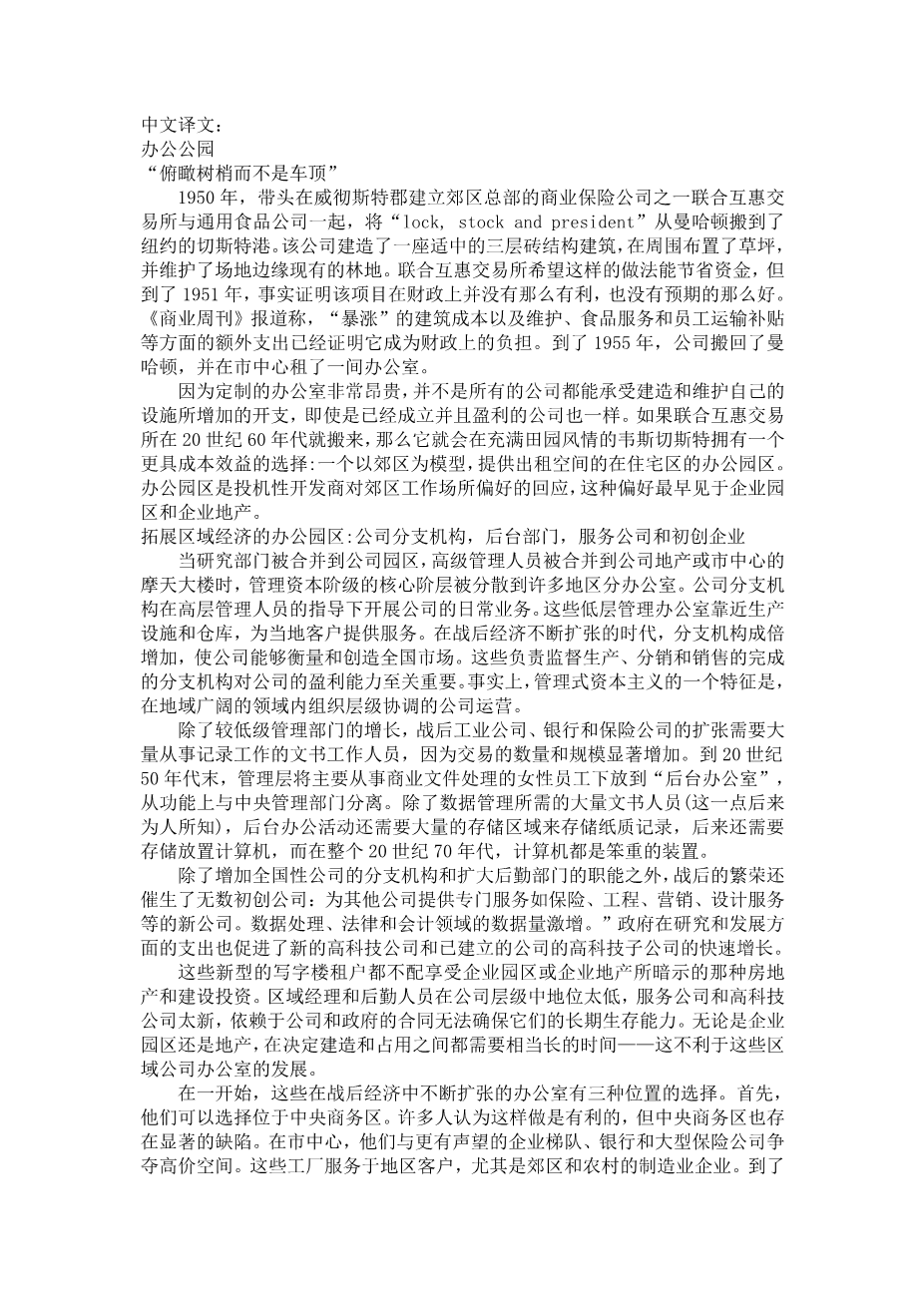南京江北新区芝麻河公园规划设计外文翻译资料
2022-08-03 11:24:13
THE OFFICE PARK
'Looking over the tree tops instead of the car tops'
In 1950, Associated Reciprocal Exchanges, one of the business insurance firms that spearheaded the establishment of suburban headquarters in Westchester County along with General Foods, moved 'lock, stock and president' from Manhattan to Port Chester, New York. The company built a modest theestory brick structure, laid out a surrounding lawn, and maintained the existing wood- land around the edges of the site. Associated Reciprocal Exchanges expected the move to save money, but by 1951, the project proved to be less fiscally advanta- geous than expected. Business Week reported that 'skyrocketing' construction costs and added outlays for maintenance, food services, and employee transit subsidies proved financially burdensome. By 1955 the company had moved back to Manhattan, where it leased downtown ffice space?
Nor all firms, even if they were established and profitable, could sustain the added expenditure of building and maintaining their own facilities because custom-built offices were pricey. If it had moved in the 19G0s, Associated Reciprocal Exchanges would have had a more costeffective choice in bucolic Westchester: an office park, with space for lease in a suburban setting modeled on the residential subdivision. The ffice park was the response of speculative developers to the suburban workplace preferences first seen in the corporate campus and corporate estate.
Office Parks for an Expanding Regional Economy: Corporate Branch Offices, Back Offices,Service Corporations,and Start-Ups
While rescarch divisions were consolidated into the corporate campus and top management into the corporate estate or downtown skyscrapers, the chird tier in the managerial capitalist hierarchy dispersed into a multitude of regional ofies. Corporate branch ffices aried out the day-to-day business of the corporate enterprise under the direction of upper management. These lower management ffices, close to manufacturing facilities and warehouses, provided services to a local customer base. In the expanding economy of the postwar era, branch offices multiplied significantly and enabled corporations to gauge and create national markets. These branch ffices, which oversaw production, distribution, and completed sales, were essential to corporate profitability. Indeed, a hallmark of managerial capitalism is the organization of coordinated hierarchical corpo- rate operations across geographically expansive terrir.
In addition to the growth of lower management divisions, the postwar ex- pansion of industrial corporations, banks, and insurance companies required large staffs of clerical workers engaged in record-keeping activities because the number and scale of transactions had increased significantly. By the late 1950s, manage- ment relegated the primarily female workers involved in the paper pocessing of business documents to back ffices,' functionally separate from central manage- ment. In addition to the large clerical staffs required for data management, as it later became known, back ffice activities needed large storage areas for paper re- cords and later for computers, which through the 1970s were bulky contraptions. In addition to multiplying branch ffices of national corporations and expanding back office functions, postwar prosperity generated innumerable start-up corporations. New companies that provided specialized services for other corporations, such as insurance, engineering, marketing, design services, data processing, law, and accounting, proliferated. Government spending fo research and development also fueled the rapid growth of new high-technology firms and high-technology subsidiaries of established corporations.
None of these new kinds of office tenants merited the kind of investment in propery and construction implied by corporate campuses or corporate estates. Regional managers and back office stafs were too low in the corporate hierarchy, and service corporations and high-technology firms were too new and dependent on corporate and government contracts to be sure of their long term viabiliy. Both corporate campuses and estates required considerable lead time berween the decision to build and occupancy- -not advantageous in the immediacy of market opportunities out of which these kinds of regional corporate offices grew.
At the outset, these expanding offices of the postwar economy had three choices of location. First, they could locate in the central business district. Many found it advantageous to do so, but the central business district also presented significant drawbacks. In downtowns they compered for high-priced space with more prestigious corporare echelons, banks, and large insurance companies. Branch oftices served regional customers, particulaly suburban and rural manu- fac turing concerns, and by the 1950s, the cscalating congestion of downtowns impeded mobility. Branch offices had less need to be near center city banks and insurance companies, as those business connections were more critical to headquarter oftices. For back office functions, the predominance of expensive, small floor plate, multistory, elevator structures was an impediment to fficient processing and storage o paperwork and, later, computing. In addition, corpo- rations perceived that their desired labor force for back ffices- -white, middle- class women- -would be found in increasing concentrations in the suburbs and not the center city.
Second, during the 1940s small office buildings began being constructed in the retail zones of residential suburbs, speificall geared to branch offices and small service corporations. Although they were widespread enough as a phenom- enon to be recognized as a particular building ype by architectural periodicals, these buildings had several disadvantages. In rerail areas, parking was limited, and tenants and their clients compered with shoppers for on

资料编号:[266262],资料为PDF文档或Word文档,PDF文档可免费转换为Word
剩余内容已隐藏,支付完成后下载完整资料

英语译文共 14 页,剩余内容已隐藏,支付完成后下载完整资料
资料编号:[266262],资料为PDF文档或Word文档,PDF文档可免费转换为Word
您需要先支付 30元 才能查看全部内容!立即支付




